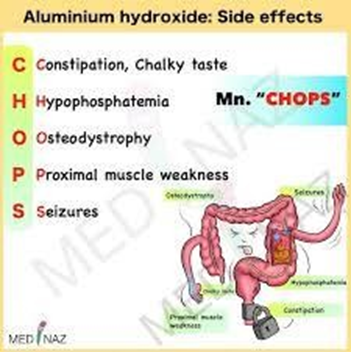A nurse is providing teaching to a client who has renal failure and an elevated phosphorous level. The provider instructed the client to take aluminum hydroxide 300 mg PO three times daily. For which of the following adverse effects should the nurse inform the client?
Constipation
Muscle spasms
Metallic taste
Headache
The Correct Answer is A
A. Constipation is a common adverse effect of aluminum hydroxide, an antacid often used to bind phosphate in patients with renal failure to prevent hyperphosphatemia.
B. Muscle spasms are not typically associated with aluminum hydroxide.
C. Metallic taste is not a common adverse effect of aluminum hydroxide.
D. Headache is not a common adverse effect of aluminum hydroxide.

Nursing Test Bank
Naxlex Comprehensive Predictor Exams
Related Questions
Correct Answer is A
Explanation
A. Salicylate intoxication can lead to metabolic acidosis due to the accumulation of salicylic acid, which increases metabolic rate and production of organic acids.
B. Thiazide diuretics can lead to metabolic alkalosis due to the loss of hydrogen and chloride ions.
C. Vomiting can lead to metabolic alkalosis due to the loss of gastric acid.
D. Diarrhea can lead to metabolic acidosis due to the loss of bicarbonate-rich fluids.
Correct Answer is ["A","B","C","D","E","F"]
Explanation
The nurse should report the hoarseness of the client's voice, which could indicate recurrent laryngeal nerve damage, which is a risk associated with thyroid surgery. Tingling around the mouth may suggest hypocalcemia, a common complication after thyroidectomy due to accidental removal or damage to the parathyroid glands. The moderate serosanguinous drainage on the neck dressing could signify bleeding or infection, which requires immediate attention. The noted tremor in both hands and the increase in temperature could be signs of a thyroid storm, a rare but life-threatening condition.
Furthermore, the client's restlessness could be a response to discomfort or could indicate a more serious issue, such as an impending thyrotoxic crisis. Oxygen saturation at 95% is within normal limits postoperatively; however, it should be monitored closely.
Whether you are a student looking to ace your exams or a practicing nurse seeking to enhance your expertise , our nursing education contents will empower you with the confidence and competence to make a difference in the lives of patients and become a respected leader in the healthcare field.
Visit Naxlex, invest in your future and unlock endless possibilities with our unparalleled nursing education contents today
Report Wrong Answer on the Current Question
Do you disagree with the answer? If yes, what is your expected answer? Explain.
Kindly be descriptive with the issue you are facing.
